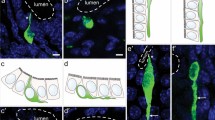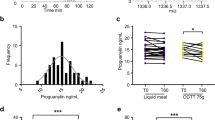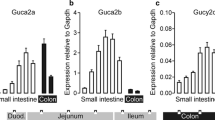Abstract
Eph receptors and ephrin ligands are membrane-bound cell–cell communication molecules that regulate the spatial organisation of cells in various tissues by repulsive or adhesive signals arising from contact between EphB- and ephrin-bearing cells. However, the expression and functions of Eph receptors in the gastric epithelium and Brunner’s glands are virtually unknown. We detected several EphB receptors and ephrin-B ligands in the pyloric and duodenal mucosa of the adult mouse by RT-PCR amplification. Immunostaining showed complementary expression patterns, with ephrin-B1 being preferentially expressed in the superficial part and EphB receptors in the deeper part of both epithelia. In the gastric pylorus, ephrin-B1 was expressed in pit cells and proliferating cells of the isthmus. In contrast, EphB2, EphB3, and EphB4 were expressed in pyloric glandular cells and proliferating cells of the isthmus. In the duodenum, ephrin-B1 was expressed in cells lining the ducts of Brunner’s glands as well as those covering villi and the upper portion of the crypts of Lieberkühn. In contrast, EphB2 and EphB3 were expressed in the gland segment of Brunner’s glands and the lower portion of the crypts and EphB4, in the crypts. In both mucosae, EphB2, EphB3, and EphB4 were found to be tyrosine phosphorylated, suggesting that EphB/ephrin-B signalling might occur preferentially in the isthmus, crypts, and duct-gland transition of Brunner’s glands, where the receptor and ligand expression overlaps. Based on these findings, we propose that EphB/ephrin-B signalling may regulate cell positioning within the pyloric and duodenal epithelium.









Similar content being viewed by others
References
Barker N, Huch M, Kujala P, van de Wetering M, Snippert HJ, van Es JH, Sato T, Stange DE, Begthel H, van den Born M, Danenberg E, van den Brink S, Korving J, Abo A, Peters PJ, Wright N, Poulsom R, Clevers H (2010) Lgr5(+ve) stem cells drive self-renewal in the stomach and build long-lived gastric units in vitro. Cell Stem Cell 6:25–36
Batlle E, Henderson JT, Beghtel H, van den Born MM, Sancho E, Huls G, Meeldijk J, Robertson J, van de Wetering M, Pawson T, Clevers H (2002) Beta-catenin and TCF mediate cell positioning in the intestinal epithelium by controlling the expression of EphB/ephrinB. Cell 111:251–263
Cortina C, Palomo-Ponce S, Iglesias M, Fernandez-Masip JL, Vivancos A, Whissell G, Huma M, Peiro N, Gallego L, Jonkheer S, Davy A, Lloreta J, Sancho E, Batlle E (2007) EphB-ephrin-B interactions suppress colorectal cancer progression by compartmentalizing tumor cells. Nat Genet 39:1376–1383
Holmberg J, Genander M, Halford MM, Anneren C, Sondell M, Chumley MJ, Silvany RE, Henkemeyer M, Frisen J (2006) EphB receptors coordinate migration and proliferation in the intestinal stem cell niche. Cell 125:1151–1163
Iwase T, Tanaka M, Suzuki M, Naito Y, Sugimura H, Kino I (1993) Identification of protein-tyrosine kinase genes preferentially expressed in embryo stomach and gastric cancer. Biochem Biophys Res Commun 194:698–705
Karam SM (1993) Dynamics of epithelial cells in the corpus of the mouse stomach. IV. Bidirectional migration of parietal cells ending in their gradual degeneration and loss. Anat Rec 236:314–332
Karam SM, Leblond CP (1993a) Dynamics of epithelial cells in the corpus of the mouse stomach. I. Identification of proliferative cell types and pinpointing of the stem cell. Anat Rec 236:259–279
Karam SM, Leblond CP (1993b) Dynamics of epithelial cells in the corpus of the mouse stomach. II. Outward migration of pit cells. Anat Rec 236:280–296
Karam SM, Leblond CP (1993c) Dynamics of epithelial cells in the corpus of the mouse stomach. III. Inward migration of neck cells followed by progressive transformation into zymogenic cells. Anat Rec 236:297–313
Karam SM, Leblond CP (1993d) Dynamics of epithelial cells in the corpus of the mouse stomach. V. Behavior of entero-endocrine and caveolated cells: general conclusions on cell kinetics in the oxyntic epithelium. Anat Rec 236:333–340
Kataoka H, Tanaka M, Kanamori M, Yoshii S, Ihara M, Wang YJ, Song JP, Li ZY, Arai H, Otsuki Y, Kobayashi T, Konno H, Hanai H, Sugimura H (2002) Expression profile of EFNB1, EFNB2, two ligands of EPHB2 in human gastric cancer. J Cancer Res Clin Oncol 128:343–348
Kiyokawa E, Takai S, Tanaka M, Iwase T, Suzuki M, Xiang YY, Naito Y, Yamada K, Sugimura H, Kino I (1994) Overexpression of ERK, an EPH family receptor protein tyrosine kinase, in various human tumors. Cancer Res 54:3645–3650
Kullander K, Klein R (2002) Mechanisms and functions of Eph and ephrin signalling. Nat Rev Mol Cell Biol 3:475–486
Merlos-Suarez A, Batlle E (2008) Eph-ephrin signalling in adult tissues and cancer. Curr Opin Cell Biol 20:194–200
Miao H, Wang B (2009) Eph/ephrin signaling in epithelial development and homeostasis. Int J Biochem Cell Biol 41:762–770
Noren NK, Pasquale EB (2004) Eph receptor-ephrin bidirectional signals that target Ras and Rho proteins. Cell Signal 16:655–666
Ogawa K, Wada H, Okada N, Harada I, Nakajima T, Pasquale EB, Tsuyama S (2006) EphB2 and ephrin-B1 expressed in the adult kidney regulate the cytoarchitecture of medullary tubule cells through Rho family GTPases. J Cell Sci 119:559–570
Ogawa K, Takemoto N, Ishii M, Pasquale EB, Nakajima T (2011) Complementary expression and repulsive signaling suggest that EphB receptors and ephrin-B ligands control cell positioning in the gastric epithelium. (submitted)
Ootani A, Li X, Sangiorgi E, Ho QT, Ueno H, Toda S, Sugihara H, Fujimoto K, Weissman IL, Capecchi MR, Kuo CJ (2009) Sustained in vitro intestinal epithelial culture within a Wnt-dependent stem cell niche. Nat Med 15:701–706
Pasquale EB (2005) Eph receptor signalling casts a wide net on cell behaviour. Nat Rev Mol Cell Biol 6:462–475
Pasquale EB (2008) Eph-ephrin bidirectional signaling in physiology and disease. Cell 133:38–52
Ross MH, Romrell LJ, Kaye GI (1995) Histology a text and atlas. Williams and Wilkins, Baltimore
Sato T, Vries RG, Snippert HJ, van de Wetering M, Barker N, Stange DE, van Es JH, Abo A, Kujala P, Peters PJ, Clevers H (2009) Single Lgr5 stem cells build crypt-villus structures in vitro without a mesenchymal niche. Nature 459:262–265
Suzaki E, Kataoka K (1999) Three-dimensional visualization of the Golgi apparatus: observation of Brunner’s gland cells by a confocal laser scanning microscope. J Struct Biol 128:131–138
Tanaka M, Kamata R, Takigahira M, Yanagihara K, Sakai R (2007) Phosphorylation of ephrin-B1 regulates dissemination of gastric scirrhous carcinoma. Am J Pathol 171:68–78
Tanaka M, Kamata R, Yanagihara K, Sakai R (2009) Suppression of gastric cancer dissemination by ephrin-B1-derived peptide. Cancer Sci 101:87–93
Verdiglione R, Mammola CL, Filotto U (2002) Glycoconjugate histochemistry of bovine Brunner glands. Ann Anat 184:61–69
Wang J, Li G, Ma H, Bao Y, Wang X, Zhou H, Sheng Z, Sugimura H, Jin J, Zhou X (2007a) Differential expression of EphA7 receptor tyrosine kinase in gastric carcinoma. Hum Pathol 38:1649–1656
Wang JD, Dong YC, Sheng Z, Ma HH, Li GL, Wang XL, Lu GM, Sugimura H, Jin J, Zhou XJ (2007b) Loss of expression of EphB1 protein in gastric carcinoma associated with invasion and metastasis. Oncology 73:238–245
Acknowledgments
We are grateful to N. Takemoto (Department of Veterinary Anatomy, Osaka Prefecture University) for technical assistance with immunohistochemical analyses. This work was supported by a Grant-in-Aid for Scientific Research from Japan Society for the Promotion of Science (to K.O.; no. 18580296 and no. 21580367).
Author information
Authors and Affiliations
Corresponding author
Rights and permissions
About this article
Cite this article
Ishii, M., Nakajima, T. & Ogawa, K. Complementary expression of EphB receptors and ephrin-B ligand in the pyloric and duodenal epithelium of adult mice. Histochem Cell Biol 136, 345–356 (2011). https://doi.org/10.1007/s00418-011-0849-4
Accepted:
Published:
Issue Date:
DOI: https://doi.org/10.1007/s00418-011-0849-4




